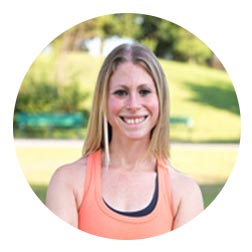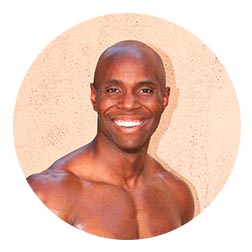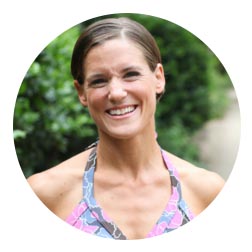While juggling to have a happy personal life and getting through the burdens of an office job, we forget to do one little thing: move enough during the day. Technology has made everything simpler, which also means less moving and a more sedentary lifestyle.
We forget that in order to be active, we don't necessarily have to run to the gym and sign for a membership. There are other simpler ways that we can adopt in order to make sure we are getting enough movement during the day. It could be from parking a little further away from your grocery story and walking to it to taking the stairs for one or two floors. Such little changes have positive impacts in our lives in the long run.
We contacted 64 fitness experts who have given us some great responses about the ways in which you can ensure you are moving enough for the day. Please read ahead to see how you can make it through the day without having to beat yourself up.
1. Abby Corsun Sims

Those who sit too much and move too little develop a predisposition to a number of health issues. There are so many ways to ensure that a full workday doesn't keep you from moving sufficiently.
These include:
- Walk to and/or from the office when feasible, or walk the shorter segments of your commute, such as between the train stop and final destination.
- Set your phone alarm (if necessary) to remind you to walk around the office at least a few times each day. It is good for your head, your eyes and your heart!
- Use your lunch break, however brief it may be, to take a short walk. Even if you brown bag it. Go outside when you can for more of a mental break. Even ten minutes will kick-start your mood and energy.
- Consider walking while talking for meetings now and then (at least for those that are are one-on-one) rather than convening at your desk or conference table.
- Take the stairs rather than the escalator or elevator - at least some of the way up and down. When on escalators, walk them rather than making it a passive experience.
- Consider an adjustable height desk at work so that you alternate sitting with standing. Spending some of your workday at a treadmill desk (walking no more than two mph while working) is a great option too (though not for every task).
- When running errands, put some distance between your parking space and the store so that you get a short roundtrip walk in.
- Find an exercise schedule and activities that work for you so that you stay fit and healthy. Once you learn to make time - and it doesn't have to be a monumental commitment - the benefits will outweigh any desire you may have had to sacrifice your health by staying on the sidelines. Keep in mind that it is possible to get all the exercise you need without using equipment, attending a class or going to the gym.
2. Dr. Ginger Garner DPT, ATC, PYT

The first thing I would suggest would be to evaluate your own best accountability practices? What does this mean in plain speak? It means - how do you best stick to a fitness plan? For most people, seeing the numbers helps. One suggestion for those who say, "show me the money," is to use a tracking app of some sort. iPhones have built in step counters, stair counters, which only require that you carry your phone with you as you move about during the day. Androids probably have something similar. For those who need more accountability, I would recommend the Streaks app (paid app) or MapMyRun (you don't have to run of course, you can change the setting to walk). Each can help you track movement, but Streaks goes a step further and will help you track water intake, yoga, meditation, and up to 6 activities total of your choice. For those who need to put their phone down in order to be mindful and aware, a FitBit may work best, since it is just a wristwatch counter, which is more unobtrusive and less bulky than a smartphone. For those who don't need to see the numbers, but need the support of real people instead of apps, try scheduling lunch breaks for early morning movement routines with friends, or in a class setting.
The overall message here is reflective of what science supports - that it's the accumulation of total activity, instead of long, singular stretches of movement, that matter most. That means getting up throughout the day and taking mini-breaks rather than making the sometimes hated trek to the gym or treadmill for a solid hour. Instead take a break every hour and no more than every 90 minutes. The brain needs this break as well as the body - in order to maximize productivity. Climb a few flights of stairs in your office building or home office, take short walks around the block, or do a few sun salutations or yoga postures between conference calls (or even during if you can!) - anything to combat the new "sitting-is-as-bad-as-smoking" mantra in the medical world.
I recommend reading the following articles:
The last piece of advice I may give is to make sure you are practicing mindfulness in the movement you choose, and to vary your routine. Whether you walk, run, cross fit, zumba, kettlebell, surf, bike, or swim - make sure your movement is mindfully driven and diverse in order to build bone mass (biking and swimming do not because they aren't a foot-to-ground activity) and to combat stress. Stress is a major risk factor in chronic pain and disease development and progression, as well as cancers, so it is incredibly important to consider movement that also includes the mind. Scientific studies overwhelmingly support that mindful movement is your best bet - think a walk or swim combined with a type of meditation that resonates with your spirituality or core values. Doing this will help preserve your DNA (which prevents premature aging), prevent expression of genetic material that causes chronic disease or cancer, help manage pain and depressive symptoms, and improve overall well-being and self-confidence.
3. Terri Batsakis

In today's busy lifestyle it is easy to get bogged down with the daily grind and forget to move and focus on our health. However it doesn't need to be complicated. I like to throw in some fun ways to move whilst getting through my daily routine.
Put on your favourite music whilst cooking and dance around the kitchen whilst preparing the next meal. Kick up your legs ‘Can-Can' style whilst waiting for the kettle to boil when making a cup of tea. Hanging out the washing? Place your washing basket a couple of meters away from the line so you need to take a few extra steps between items. Avoid lifts wherever you can, opting for stairs, and finally, go for a walk whilst waiting for the kids to finish extra-curricular activities, rather than surfing the net. Every bit of movement counts, even if it isn't prescribed exercise.
4. Tony Bonvechio

I'm of the belief that doing a little a lot is better than doing a lot a little, so carving out even just 10 minutes a day for exercise can be enough. Whether it's going through a head-to-toe mobility routine, doing sprints outside or on a bike, or doing a few sets of heavy strength training like squats or deadlifts, that can often be enough to spark change, especially if you're new to exercising. I like the idea of rotating through each goal each day, so you're doing three days each of mobility training, sprints and lifting weights each week, then resting completely on the seventh day.
5. Kathleen Trotter

Adopt the mantra "daily motion is a non negotiable - a when not an if". How you fit in the motion is what is up for debate.
Goal#1 - Make your goal to "sit less and move more". Consider tracking your steps. First, you will have to figure out how many steps you take daily. Once you have figured it out, you can aim to increase the number of steps by a few hundred until you have reached 10,000 steps.
These are some of the simple ways to get to your goal:
- During your lunch hour, consider taking a walk with a colleague
- Get off your transportation vehicle a stop earlier and walk to where you are supposed to be
- Park a few minutes away from the store or the destination and walk there
- After dinner, you can take a walk with your partner
- During the weekends, you can try walking to run your errands
- Leave stuff in different parts or floors of the house so you are forced to walk in order to retrieve them
Goal#2 - It is also important to get your stretches or corrective postural exercises. You can do them at your desk, inside the car, on the sofa, or basically anywhere you are confined to sitting in one position. These stretches will reduce the negative effects that sitting have on your body. It also improves one's quality of life.
Examples of such stretches or postures can be:
- doing core exercises
- stretching your legs and back when you are on your bed
- using a door frame or anything sturdy to stretch your chest
- take short breaks to stretch when you are sitting at your desk
6. Jennipher Walters

If you've got a full day of work and errands to do and want to make sure you're moving enough, start by getting up just 10 minutes earlier than normal. With that extra 10 minutes, do a little stretching (or yoga if you know some poses) to wake up and then do a quick circuit -- 10 jumping jacks, 10 push-ups, 10 squats, 10 sit-ups -- three times through. Then go about your day, taking the stairs and parking farther away whenever possible. Also, get creative and see where you could be active more (walking to a co-workers desk instead of calling or standing while on the phone) and when you are walking, walk quickly. Once you get home, try doing some lunges while you wait for food to cook or even some calf raises while you're brushing your teeth. Every little bit adds up! But starting with a good 10 minutes first thing, definitely puts your fitness fit -- and sets a nice and healthy tone for the day.
7. Krista Wickens

Whether you are a stay-at-home mom, busy career climber, or a weekend warrior; purposeful movement is where the magic happens to improve strength, burn calories and develop overall wellness.
There are opportunities every day to add benefits to your movements. Let's look at two basic activities that can become more purpose driven with a few minor adjustments:
The Active Sit
Many of us spend on average 8+ hours sitting at our desks, traveling in planes, trains and automobiles or on the couch; top that off with another 6-8 hours sleeping. That can add up to nearly 20 hours of sedentary sludge. Sitting invites stagnation and our fascia (the material protecting and supporting our body as a unit) begins to reshape so we start to take on the shape of our chairs. Our hips become tight, ankle movement diminishes, our shoulders push forward, we forget to engage our core as we slouch and collapse our lower back, and our necks crank towards the screen.
One way to combat the negative effects of sitting is to think about how actively you are sitting. Set a timer – every 20 minutes – get up and walk around for 3-5 minutes. Get the blood flowing through your body. Then reposition and try an active sit. Focus on pulling your navel to your spine, shoulders back, glutes engaged (squeeze your butt cheeks together) and hold the position for as long as you can. Repeat 3-5 times. Another opportunity to change the dynamics of sitting is to add a balance cushion to your chair. The unstable surface challenges us to remain mindful throughout the day of how we are sitting and helps to trigger the core to engage as we shift forward and back.
Walk the Walk
To and from your car, shopping for groceries, walking through an airport, your daily dog walk, wherever you go… there are many opportunities to walk with purpose. Think strong core (navel to your spine), shoulders back, head up, and glutes engaged as you walk. These small mindful adjustments will help to create more purpose in your movement which equates to stronger muscles and more calories burned.
Being mindful of any movements we do, and how we do them, is the key to creating movement with benefits.
8. Chris Ryan CSCS, NSCA-CPT

"Everyone seems to be busier lately; work, errands, shuttling the kids around so who has time to workout? You do!
You may not have enough time to get to the gym for an hour, but that doesn't mean you can't take the stairs a few extra flights to your office instead of the elevator. Also, park at the far end of the parking lot when you grocery shop and "farmer carry" your bags back to your car. If you find yourself at your kids baseball game add in some simple body weight exercises each inning like planks, push-ups and squats in between watching them hit home runs. The opportunities are endless, you just have to think outside the box a little more.
There are never enough hours in the day to accomplish all you want to do, so don't fight your schedule, but rather let it work for you. There are countless ways to move your body throughout the day. And the easiest one of them all is a simple one: walk as much as you can. The healthier 'you' is just around the corner."
9. Andrew Walker, Physical Therapist

In this day and age we are fortunate to have various devices that can help us to become and remain active. This is incredibly important for people, especially those with diabetes!
Many people have smart watches, fit bits and similar that help us keep track of the number of steps we walk each day. This is a great technology, but sometimes people pick too high a target and then try and get them all done at the end of the day in a burst. Instead, I would encourage people to pick an achievable number of steps and try and distribute them through the day. I would also encourage people to increase their goal steps as they progress.
We also have apps and computer technology that can help remind us to change posture regularly. Notice that I did not say to sit, stand or walk with a straight or “good” posture. Instead we know that specific postures are not related to pain, but instead a lack of movement is. Sit in “good” or “bad” posture for too long and you will have potential for pain. We can make use of various apps can give you reminders at predetermined intervals to help keep you moving. An example is the Google Chrome extension Posture Minder (https://chrome.google.com/webstore/detail/postureminder/dkmkfopiihabelocpelofchappjjnpkm?hl=en) or Time Out on the Mac (http://www.dejal.com/timeout/). If you are in an environment where you don't have access to these tools (e.g. driving), or if you are not keen on tech, you can use other visual cues to remind you to change posture and move. A great example is putting a red sticky dot in the corner of the rear-view mirror or somewhere on the dash - whenever you see it you make a change in posture. This can be extremely helpful when in the car for trips longer than 15-20mins!
When you make small changes and have periods of activity through the day you will be amazed how much better you feel! Exercise is one of the best forms of medicine and if done sensibly, carries a low risk! Move and keep moving!
10. Sue Falsone PT, MS, SCS, ATC, CSCS, COMT, RYT

Time is the biggest barrier to an active lifestyle. Remove the expectation that the only way to get in shape is by going to the gym for an hour every day. This time commitment is simply not realistic for most of us. Often a 15 minute, high intensity workout is enough. Work hard for a short period of time and move on to your next task. There are many programs like this that offer free guided, body weight workouts, which means they can be done anywhere at any time.
If you feel like you can't fit even 15 minutes in, simple movements during your day can add up. For example, take all of your phone calls at work while standing. If you let your dog outside, do squats or lunges or push ups until they are ready to come back inside. Add a set of push ups on the bathtub after every time you brush your teeth.
By adding in body weight activities in between your daily tasks, or simply getting up and away from the computer/ phone you can be sure to move enough during the days when you feel like all you are doing is running around.
Also check out http://suefalsone.com/reduce-your-injury-potential/ for other ideas on how to feel better during the day
11. Aaron LeBauer PT, DPT, LMBT

The best ways to make sure you are moving around enough each day is to carve out 20 minutes 5 days a week for a brisk walk. Walking around the grocery store or getting around town is of course physical activity, but it's not exercise or enough sustained activity to increase your body's metabolism and get the endorphins flowing. The #1 best thing to do is go for a brisk walk at the same time each day and find a friend or accountability partner to join you.
12. Joy Victoria

"The simplest way to make sure you are moving enough every day is to commit to 30-60 minutes of intentional exercise, everyday."
13. Nancy Newell

Start with WHY
Knowing your why is crucial but commonly overlooked step when it comes to laying down a path to achieve small process goals (daily goals) that will lead to your long-term goals. Here is a common conversation I have on a weekly basis with some of my clients.
Me: Why do you want to lose 20lbs
Them: To look and feel better
Me: Why do you want to look and feel better?
Them: So I can play with my children and go on family vacations
Me: Boom! That's your Why! Your future memories and experiences with your children
Once you find your why you now have found a rewarding purpose. Something that is going to motivate you and drive you to be successful.
Set process goals
There are two basic types of goals. There are process goals and outcome goals. Process goals are things you need to do every day to help you reach your outcome goal. Outcome goals are long-term desired results and are heavily dependent upon continuous effort.
Click this 4min video to learn how to set process goals that will help you move more often and feel better.
Set a timer
For many people with a desk job it's the 7-8 hours of extremely light to zero activity that comes with sitting at a desk. I have found that setting a timer on your phone every hour on the hour and performing some type of light movement helps burn calories, rejuvenates the mind, and increases happiness. Here is a sample routine below. You will need to purchase a small half-inch band.
A1 Stand Up and Perform 5 Deeps Breaths (full inhales through nose and exhales through mouth)
A2 Standing Neck Rotations to the left and right, Flexion and Extension (up and down) x6 rounds
A3 Standing Band Pull a-parts -10 pronated 10 supinated
A4 Toe Touch x5 with full exhale
A5 Squat to Stand x5
A6 Sit in chair and rollout bottom of feet with Baseball/lacrosse ball
14. Chris Freytag

My best tool- a standing work station! You can buy one or do a DIY station. I stand for most of the work day. It keeps my posture better but it also makes me more apt to walk around... go get a glass of water, take a lap around the office, take a bathroom break. I also try to walk my puppy everyday - adding at least 1 -3 miles to my activity. Sometimes it's morning, sometimes it's evening but I'm motivated to do it because “she” needs the exercise which gets me out there too! One more tip – throw in a few exercises at night when you sit down to watch TV. Grab your stability ball and do some ab tucks, push ups and hamstring roll ins!! Quick and easy!!
- http://gethealthyu.com/exercise/stability-ball-ab-tuck/
- http://gethealthyu.com/exercise/stability-ball-push-up/
- http://gethealthyu.com/exercise/stability-ball-hamstring-roll/
15. Lynn Ludwig, ACE Certified Personal Trainer

Consider your every day life as a work out session.
That means get creative with what you do every day. At work, if there is a big parking lot, park as far away from the building as you can so you can get some walking in, the same goes for shopping. When you're walking, challenge yourself with a power walk to the building.
Instead of the elevator, take the stairs. If there is only an escalator, walk it instead of having it take you to the next floor.
At your desk, or anywhere you spend a good amount of time at, you can perform exercises such as squats, lunges, push ups and chair dips.
Take your dog on more frequent walks, or your cat if he's trained to do so. That's about 15 - 20 minutes of exercise right there. Playing with them is exercise for you too.
Right before bed, spend a few minutes working your muscle groups, whichever you choose for that night. Then the next night, choose a different muscle group, and rotate from night to night.
For weight loss; HIIT, Tabata, or even just a circuit takes a minimal amount of time to burn calories. Along with a healthy eating habits of course.
As long as you're moving, you're doing ok. Talk to your doctor if you have any concerns. Once again, get creative. Just understand, whatever type of ailment you may have (if you do), it shouldn't stop the rest of you from being healthy. Make yourself limitless.
16. Dean Somerset BSc. Kinesiology, CEP, CSCS, MEPD

"The easiest way to get more activity while running errands and working are to do simple things that make you move a little more than you would otherwise. If driving, park farther from the entrance to the stores you're planning to go through. If possible, walk between places you have to go, carry bags instead of putting them into a shopping cart, and take the stairs instead of the escalator. At work, try to get up and move at least once an hour, whether it's to go to the printer or water fountain or to talk with someone face to face instead of through email, and take walks on break times or lunch to get some blood pumping through your body."
17. Phyllis Rubin

The best method for me keeping active is to take classes I love. If I have an appointment I will keep it and if I love the activity I won't miss the session.Use a Fitbit or a pedometer to count how much activity occurs during each session. Try for 8,000 to 10,000 steps a day.
18. Brett Neilson, DPT

Finding the time to get enough movement or exercise in a day can be challenging for working professionals as well as active family members. The American Heart Association (AHA), recommends 150 minutes of exercise per week or 30 minutes of continuous exercise 5 days per week.
The best way to be successful with achieving this goal, is to make movement and exercise part of your daily routine. There are a lot of low cost fitness trackers on the market along with free apps for your phone such as Moves or Stepz that can count your steps. Having real tangible data will help you set a goal, realize it and achieve it. Once you have a tracker in place, there are simple strategies to move more, such as park further from the front entrance of work or the store when running errands. Also, choose to take the stairs instead of the elevator. Drink lots of water, so you will need get up and use the restroom more frequently.
These a great strategies to help you boost your step totals, but do not necessarily help you meet the AHA recommendations. In order to meet the AHA requirements, you will need to do 30 minutes of continuous exercise or movement. Walking is a great form of exercise that is low impact on your body. Try going for a walk in the morning, over lunch or in the evening. Many employers now have treadmill desks that can be used during the day while checking email. Another great strategy is to get your family involved. Go for a nightly post-dinner walk with the whole family. Not only is this great for your heart, but it will also boost your metabolism helping with digestion and weight loss. Other great forms of low impact activities are riding bicycles, elliptical trainer, hiking, and swimming. Try to implement one new thing each week until you meet your fitness goals.
19. Sonia Satra

With a crazy-busy schedule, getting enough exercise can feel impossible. But with a simple shift in mindset, you can turn even the most hectic day into an energized and active one. Here are some tips on how to do that from mind-body expert Sonia Satra:
- Take advantage of what you're already doing. You don't have to make radical changes to your schedule to move. Instead, look for places you're already moving, and capitalize on that. Making dinner? Do squats or wall push-ups while the water boils. Grocery shopping? Speed-walk through the store. Watching your kids? Play with them! Kids' games burn between 150-350 calories in just half an hour.
- Then, take that a “step” further. Where in your day can you add movement? Turn meetings into walking meetings (it'll boost creativity too!). Invite your friends for a stroll or yoga instead of a drink. Do crunches during your favorite TV show.
- Shift your focus. Instead of telling yourself “I don't have time today,” ask “What do I have time for?” Even if it's just ten seconds of toe raises, or thirty seconds of arm circles – do it. Those little moments add up fast.
- Give movement meaning. While you're doing those dinner-making squats, name things you're grateful for. With each crunch in front of the TV, name something you love about yourself. It'll improve your mindset while you improve your body - so you'll be happier, more energetic, and less stressed. Which means it'll be easier to find the time to move more!
- Make it a game. Give yourself points for every time you add movement. Try to beat yesterday's score every day for a week. Get your friends, coworkers, or kids in on it, and add (healthy) prizes for the winners.
- Make an “I did” list instead of a “to do” list. “To do” lists can be overwhelming, but “I did” lists help you acknowledge your success. At the end of the day, write down every time you moved, no matter how small or short. Do this every day for a week. Writing your movements down will make you want to move more, plus, you'll feel great
20. Dr. Heidi Jannenga, PT, DPT, ATC/L

Moving around at work is a great start to reaching a daily movement goal. A good rule of thumb is to make sure you stand up and move around a bit each hour. Incorporating small changes to your routine—like taking the long way around the office to the bathroom or water cooler—is the simplest way to integrate movement into your day. There are also many apps and wearable devices on the market that track activity and provide reminders at regular intervals.
This was actually a big challenge for me when I made the transition from physical therapist to software executive. As a physical therapist, I was treating patients all day, so I was constantly up and active. I was not used to sitting at a desk, so when I moved into my full-time role at WebPT, I intentionally integrated activities that also aligned with my professional goals. For example, it was very important to me to be accessible and visible to my team, so I dedicated time to regularly walking around to catch up and check in with everyone. You will often see me pacing in my office while on a phone call. I also installed a treadmill desk in the office, which allows me to catch up on my email while logging steps. And speaking of email, while it is a convenient—and in this day and age, necessary—method of communicating with colleagues, I always recommend getting up and walking to someone's desk to ask a question or have a conversation. The simple act of standing up and walking at regular intervals throughout the day is so important when you have a desk job. Plus, the face-to-face interaction is good for relationship-building.
21. Ben Shatto, PT, DPT, OCS, CSCS

It's easy to let the busyness of life keep us from taking the steps necessary to insure a long life span and health span. The good news is that frequent short bouts of exercise can be effective for maintaining general health. The key is to incorporate frequent movement into your daily routine.
Get up and move at least every two hours during the day. One option is to perform ten sit to stand exercises every hour.
(Simply, move from sitting to standing for ten repetitions.) Another option is to walk at least every two hours for a minute or two. The faster the walk, the better! If stairs are available, walk up and down. Combining the sit to stand exercises with walking is an excellent and fast way to elevate your heart rate no matter where you are! Try parking further out in the parking lot when you're out running errands. It will force you to walk further.
Finally, make time to connect with not only yourself, but loved ones, too. Walking after meals has been shown to stabilize blood sugar levels. It's also an excellent way to boost metabolism and connect with friends and family. Frequent walking is the most important physical activity you can engage in.
22. Scott Laidler

"The best ways to ensure that you are getting enough activity throughout the day is to build movement into your habitual daily life. Habits that are forged and enforced over a series of weeks become well established and are more likely to be held over the longer term. One example would to be to build a very short circuit into your morning regimen, something as simple as 5 squats or 30 seconds of star jumps is enough to get your heart pumping and your nervous system firing.
As the day goes on, be sure to take brief breaks whenever you are sedentary for more than 2 hours in a block, this is a realistic goal and the movement needn't be more than a few minutes, again articulating through the full range of motion of your hips, shoulders, knees and ankles and aiming to get your heart pumping a little faster for a brief period of time.
Another tip is to pick-up any ‘easy wins' you have available to you, which means being active whilst dong things that you would have done anyway, such as walking or cycling during routine phone calls, talking walking meetings or picking up cardio exercise whilst enjoying your favourite TV shows or podcasts. These habits should all run in conjunction with your actual workout regime or yoga practice but don't make the mistake of thinking that a good workout negates the need for a regular movement and activity"
23. Michelle L Collins, ACE Certified Personal Trainer & Fitness Nutrition Specialist

The U.S. Department of Health and Human Services (HHS) recommends adults perform 150 minutes of moderate or 75 minutes of vigorous cardiovascular exercise weekly to achieve basic fitness. While this benchmark is difficult for most people to achieve without incorporating dedicated workouts, there are ways we can add movement to our daily lives that count toward those goals. In addition, recent studies have shown prolonged sitting raises risks for cardiovascular disease, even for people who meet the recommendations. So whether we workout regularly or not, we should be getting up and moving throughout the day.
Choose standing over sitting, walking over standing and walking greater distances or more vigorously over short strolls:
- Stand while folding laundry
- Walk while talking on the phone or conduct walking meetings
- Take stairs instead of escalators and elevators
- Park in spaces furthest from the door
- Use restrooms on a different floor or furthest from you
- Use half or all of your lunch hour to take a walk
- Use a hand basket instead of a cart in stores
In addition to the cardiovascular recommendations, HHS recommends performing regular weight bearing strengthening and flexibility exercises. Stretches for the back and hips are especially helpful for people who sit at a computer most of the day. Take regular breaks from your desk to walk and stretch. I recommend incorporating strength exercises (squats, lunges, push-ups, planks) during wait times, such as waiting for water to boil, an oven to pre-heat, a laundry load to finish, an app to update or software to download.
- HHS recommendations: https://health.gov/paguidelines/guidelines/adults.aspx
- Risks of prolonged sitting: http://www.health.harvard.edu/blog/much-sittinglinked-heart-disease-diabetes-premature-death-201501227618
24. Bill Boland, Exercise Physiologist

How to keep moving all day long. Start with "active sitting”.
Steve Jobs was at his most creative while walking and thinking outside in the park next to his office, and we can be, too. Apple's founder knew that the body and mind respond to nature and to moving. Let's take a page from his book and use some easy-to-do tricks to keep moving all day.
We start the day on the run and yet, we forget to move. We have a thousand and one things to do, but we're not moving to do any of them. How is that possible? It's simple. We email or text everyone; the cell phone is glued to our ear while our butt is glued to the chair, we order online, direct deposit our checks, make reservations online, and stream Netflix online.
We're busy but we are not moving. This “inactive movement” is harmful to our health, elevating blood pressure and cholesterol, increasing conditions for diabetes, and weakening our bone density and muscle strength.
Here are a few simple steps you can take to turn your daily sitting into “active sitting”, into non-traditional exercise, into movement.
- Make a commitment to move at every opportunity, starting with that phone call. Make it standing up; walk around and talk. You don't make a presentation sitting down; think of the phone call as a presentation, too.
- Stand whenever you can. Mix it up with sitting. Use a timer to go off every 20 minutes to remind you to get up and walk around. Go walk and talk to a colleague down the hall; save the texting and email for another time.
- Organize a meeting outside and walk while you solve the world's problems. This may not work for ten people, but for three or four, it will.
- Set up your office and home office space to maximize reaching and moving. Keep the phone ten feet away, so you have to get up and answer it. Filing cabinets and printers can go on the opposite wall.
- A good chair or balance ball chair is a must. Slouching kills. A perching or wobbly stool does wonders for balance while it works your core muscles.
- Keep an exercise band or yoga mat in the office. Five minutes of resistance work and a quick Overhead Arm Extension will do wonders!
- Take the stairs whenever possible. Park as far away as possible from the office building or mall entrance. Walk a few laps instead of a big lunch a few times a week. Remember how wonderful lunges and squats are. Do them often; they don't have to be perfect, just done
25. Monique Alhaddad

We all have those days from time to time. A busy day at work, followed by evening plans, and in between you have a ton of errands to run. Don't have time to hit the gym? Here are a few things you can do to make sure you're getting enough movement throughout your day.
- Take the stairs when you can instead of riding the elevator.
- Go for a brisk 15-min walk on your lunch break.
- Throughout your work day, stand up and perform basic exercises, such as body weight squats for 12 - 15 reps or push ups against a wall for 10 - 12 reps.
- If you have access to a stability ball, bring it to work and use it to sit at your desk instead of a chair. Your core will engage while you sit on the unstable surface of the ball.
If you sit a lot during your day, and you don't have time to fit a workout in, get up and move around as often as you can. Being sedentary for long periods of time is never good for our bodies. Incorporate some of these extra movements into your day, and your body and soul will thank you.
26. Tara Allen, RN, CHC, CPT

You've been told to increase the amount of exercise you're getting, but you're busy! Between work, chores, and social obligations, there's little time left over for you.
I understand! That's why I'm sharing my top tips for staying healthy and active on your busiest days.
- Try setting your alarm a little earlier to squeeze in a quick workout before starting your day. Even 10-20 minutes of walking, yoga, or bodyweight resistance exercises (such as pushups) make a big difference in your health.
- Make good use of your commute by doing isometric exercises. This is just a fancy way of saying squeeze your muscles.
- Concentrate on one body part at a time (abdominals, for example), tighten for a count of ten and release. Do a few sets of this for several different muscle groups and you'll be energized before you even hit the office!
- If you have a desk job, set an alarm on your phone to remind you to get up once an hour. A quick stretch, walk to the bathroom, or set of squats next to your desk are perfect ways to get the blood pumping without taking up too much of your time.
- While you're at it, see if you can get creative and put together a make-shift standing desk to break up some of the sitting throughout the day.
- Aim to go for a walk during your lunch break or climb a few extra sets of stairs for a mid-day pick-me-up.
- With Summer around the corner, this is the perfect time of year to make your phone calls outside while going for a quick walk.
Earn your screen time! Commit to one set of lunges, sit-ups, or lunges during each commercial break (or every 10 minutes if you're skipping the commercials). - Add adventure to your weekends - date nights, time with kids, or time with your friends can all include activities such as hiking, bike riding, playing ball, and taking walks.
When you change the way you look at things, the things you look at will change. The world is our playground! With a little planning and a bit of creativity, we can incorporate exercise and movement into our busy lives.
27. Lawrence Biscontini, MA, Mindful Movement Specialist

1. Get an Apple Watch or similar device to hold you accountable for your total movement activity
2. Strive to get more activity: park far away from the front of the mall, grocery store, or gym; walk on every single escalator
possible; ask to take stairs instead of elevator; make a standing desk everytime you check Facebook or do social media; hold all phone conversations when you walk around instead of sit—it's also great mutli-tasking brain fitness unifying both sides of the brain, working your mouth, and getting your heart involved, too!
3. Find others who have the same goal because research shows that social support figures among the highest predictors of efficiency, efficacy, and effectiveness of movement goals.
28. Jane Torbinski

According to the American Diabetes Association regular physical activity is a key part of managing diabetes along with proper meal planning, taking medications as prescribed, and stress management.
Whether you are busy working or running errands it is important to keep moving throughout the day. To include physical activity as part of your self-care program try these small steps.
- Stand at your desk, switch to an adjustable stand-up desk
- Stand while talking on the phone, pace if you have the space
- Take a walk during your lunch break
- Take the stairs instead of the elevator
- Park your car far away from the entrance
- Do some lunges, squats or march in place https://en.wikipedia.org/wiki/Lunge_(exercise
- Do leg stretches on a chair or staircase
- Do shoulder blade squeezes https://homegym-exercises.com/shoulder_blade_squeeze.html
- While waiting on line at the store stand tall and tighten your abdominal muscles
- Try wall sits to strengthen glutes, quads, and core https://en.wikipedia.org/wiki/Wallsit
- Put on some good music and dance while cleaning the house!
Sit less, keep moving and have some fun!
As with all exercise programs, check with your physician to ensure a particular exercise is right for you.
29. David Neira, IFBB Certified Personal Trainer

First of all, thanks for inviting me. I appreciate the opportunity to meet the awesome members of this community. My grandfather had diabetes and I know how hard it can be. You know better than me how important diet is to stay healthy. But let's not forget exercise.
I don´t want to take for granted that everybody knows how much is enough exercise. To stay healthy or to improve health, adults need to do three types of physical activity each week: aerobic, strength and stretching exercises. If you want to read the full Physical Activity Guidelines for Americans, here: health.gov
The Department of Health and Human Services recommends 150 minutes of moderate aerobic activity or 75 minutes of vigorous aerobic activity a week, or a combination of moderate and vigorous activity. (See Mayo Clinic Web). To find what´s "moderate activity" try the “talk test”, exercising hard enough to break a sweat but not so hard you can't comfortably carry on a conversation. Vigorous activity makes you breathe hard and fast. At this level, you won't be able to say more than a few words without pausing for breath. You can combine moderate and vigorous exercise over the course of the week, and it's fine to break up your activity into smaller bursts as long as you sustain the activity for at least 10 minutes.
The same Department also recommends strength training exercises for all major muscle groups at least two times a week. Studies have shown strength training to increase lean body mass, decrease fat mass, and increase resting metabolic rate. Weight training has also been shown to help fight osteoporosis.
The American Heart Association recommends that healthy adults engage in flexibility training two to three days per week, stretching major muscle and tendon groups.
I know all this exercise seems a lot from the point of view of busy people, but all of it only takes one hour, 4% of your day. Remember, you can break up your activity into smaller bursts. If your job keeps you moving all day long, activity trackers (apps or wearables) are the simplest option to keep track of it. Forget daily steps and aim for at least 30 minutes of brisk walking. You do so, daily aerobic exercise is done.
Stretching at the workplace is something we all should do, but very few do. Whether you work behind a desk, drive for hours, or spend long hours standing (as waiters and watchmen), some muscles get tired and you feel stiffness, soreness, and at the end of the day, even pain. You can prevent this by taking a few 5 minutes breaks along the day to stretch and relax problematic areas like legs, lower back, shoulders, neck, and wrists. 3 little breaks and you´d be stretching 15 minutes every day.
Strength training doesn´t mean gym membership. There are multiple ways to strengthen your muscles at home or at the workplace: bodyweight training, resistance bands, suspension training... Choose whatever best fit your abilities and taste. To keep track your progress is recommended to write down your training sessions. A simple notebook or a taking notes app will do the work.
The best and simplest way to make sure we are doing enough exercise is keeping track of what we do. On the weekend, we should check our work and plan our next week accordingly. Maybe we´re doing good and just need to stick to the plan, or maybe we´re not doing enough and we have to push a little bit harder.
I hope you´ve enjoyed the reading. I´ll be pleased to answer your questions and comments if any.
30. Shanna Farrar

Being active in your busy day can sound daunting at first, but there are some easy ways to create small changes in your routine that can help make a big impact throughout the day.
DURING ERRANDS: Stop looking for the closest parking spot. When you are running multiple errands take advantage of the empty spaces further away from the entrance. By the time you are done with your To Do list, you will have added in a good amount of extra walking. If you use public transportation, get off the bus or subway a stop early.
AT WORK: Set a timer on your phone for every 55 minutes. When your alarm goes off, it's time to get up from your chair and stretch or go to the water cooler. Doing these five minute breaks once an hour will add up during the day. Also, try standing during phone calls rather than sitting for long periods of time.
AT HOME: if part of your daily routine is house cleaning, see if you can get your body really moving during this time. Set a timer for 5, 10, or 20 minutes and see what you can get done in the shortest amount of time. This will have you moving and you'll end up with a clean house.
If you have a dog, make sure to walk him every day which is not only good for both of your bodies, it's a great time to bond. Try setting your alarm clock for ten minutes earlier each morning and set goals to do 10 exercises each for one minute. Examples could be lunges, squats, jumping jacks, and crunches.
A body in motion stays in motion!
31. Meagan Kolakowski

In my opinion, the best (and easiest!) way to make sure you are moving enough throughout that day when you have a bunch of errands to run is to park far away from wherever you are going. If you have to make a Target run, park towards the back so then you have to walk a bit more than usual. If you have to go to a Dr's appointment where you will be sitting for longer periods, park in the lot next to the doctor's office lot. If you can, shop in malls where you walk more and sit less to drive place to place. While you're waiting in line, do high knees or modified jumping jacks. You may get some crazy looks, but at least you are moving and using the most of your time!
32. Mike Reinold

One of the biggest recommendations I often give them is to try to reverse their posture at some point in the day. We tend to sit and perform many repetitive tasks in our lives. Our body needs movement variability. For example, if you do need to sit for a lot of your day, you should be sure you do stretches, take a walk, and just be upright to "reverse your posture" at some point throughout the day.
33. Jennifer Nyp

8 THINGS YOU CAN DO TO MOVE MORE
Let's face it: we're all busy. Whatever your situation you're probably wondering if you are moving enough. If you live in New York City, you probably are. If you live in a place where you drive everywhere, you probably aren't. Dear friends of ours moved from Brooklyn to Los Angeles and the wife called me to tell me she's having a hard time with the transition. “I'm probably the only person who ever moved to LA and gained weight.” Most likely not, but we figured out a way for her to workout during her lunch hour. Luckily, there are gyms and classes everywhere there. You might not be so lucky to have easy access to a gym. There are some easy tricks to sneak in some extra movement time in your routine.
1. TAKE THE STAIRS. My 7 year old used to ride her scooter to school, which consisted of me running and pulling while she just stood there. Lately, we've been taking the subway and at first the stairs were killing her. I noticed that after a few weeks she wasn't complaining or breathing heavy. It takes a very short time to acclimate to new movement patterns and challenges.
2. PARK FURTHER AWAY. If you drive you park. Park as far away from your office or that store your visiting. You'll log extra miles in no time.
3. STAND UP. If you work sitting down or you just find yourself parked a lot, pick an activity that is your “standing” signal. For example, every time you take a call stand up.
4. WALK/RUN TO DO ERRANDS. When I was getting married I had so many appointments to get to, sitting in traffic was not an option. I started running to all of my appointments. I have the advantage of working in workout clothes and I shortly got over caring how I looked to pick out my flowers. You may not be able to do this on a workday, but you can probably do it on the weekend or a non-workday. Even on the weekends, I will run to the grocery store or wear workout clothes to the park with my kids so I too can run around with them. Everyone has more fun and I move way more then when I'm in my jeans sitting on the bench.
5. STAND UP EVERY HOUR. Set your apple watch or phone or whatever you have to buzz you every hour and remind you to stand up.
6. WALK INSTEAD OF WAIT. Walk around while your child is at that dance class or basketball game or if you are early to appointment (you are my hero!) walk around the block until it's time to be seen or take the coffee break and make it a coffee walk.
7. WEAR A FITNESS TRACKER. My husband's office is 8 blocks from our Apartment and yet he used to take a cab. I got him a fitness tracker and one day he only logged 300 steps. That was a huge shock to him (not to me really) and he started walking to work and elsewhere. You can only improve your habits if you have the data.
8. TAKE A CLASS. There are so many classes offered now with no membership fee. You just pay for the classes you take. If you can get to ONE CLASS per week, it will make a huge difference in your energy, self-confidence and motivation to continue. People in motion tend to stay in motion, so get moving! You'll be glad you did.
34. Dr. Andrew Ball, PT, DPT, PhD, OCS, CMTPT, CertMSKUS, PES

Don't worry about “enough” just do more. Measuring toward some arbitrary far-off goal is the best way to end up frustrated and defeated. Marathoners don't just wake-up one day and run Boston . . . they start running their local parks, then a 5K, then train for a half-marathon, etc. Cut yourself a break. Don't strive for “enough,” just strive for “more.”
- Measure. You'll need to track your progress so you have a good idea if you're moving more. Digital pedometers come in all forms --- from smartwatch and smartphone apps to inexpensive ones that that be purchased on Groupon. Get one and start measuring your progress (or lack thereof).
- Make it a habit. I often hear the excuse “I didn't have time” to do exercise (be it for performance, for conditioning, or for rehabilitation). The hardest part is getting started, so make it a daily habit. When patients give me the “I didn't have time” excuse, I ask to smell their breath . . . and it's always minty fresh. My point is that if you had time to shave, brush your hair, and brush your teeth, you had time to do a few morning exercises; which brings me to my final suggestion.
- Make it simple. There is no need to do complicated exercises. When you're getting started, or encouraging a friend or loved one to get started, just get down to the basics --- squats, lunges, curls, and push-ups can be done easily in the home, by the side of the bed, as part of a morning routine. Once the simple habit is established, then refine.
- FIDGET! (aka MOVE, just MOVE). Ever see a 4 year old in chronic pain? Almost never. Kids are not confined by social norms. They squirm, they stretch, they “get out the schpilkies” in socially awkward and inappropriate ways for an adult to do. It may not be appropriate for the board room, but (especially if you work a desk job) get up and stretch on a routine basis.
35. Christa Bache, M.A.

Tracking your steps per day or mileage.
1. You first need to track how many steps you take each day.
There are many devices you can use to track your steps per day such as a pedometer, Fitbit, iPhone or even just counting how many blocks you walk.
2. You have an ongoing record of how many steps you take each day.
You can go high tech with a device that sends you a weekly notification of your steps or lose the tech completely and record your daily pedometer steps or block counting in a notebook.
At the end of the day, you need to find the right device and method of recording that is correct for you. The right choice is the one you can commit to on a daily basis.
As with any goal you need to know where you are to determine where you want to be.
Set goals based on small incremental changes. If you're currently walking 5,000 steps per day, simply add an additional 500-1000 steps per day. Then you'll slowly bring up this number as the weeks go on and you remain consistent.
36. Sara Haley

5 Simple Ways To Make Sure You Move Enough Each Day
- You hear it ALL the time because it's the truth - when you can, WALK! Walk to your errands, take the stairs at work, park farther a way in the parking lot so you have to move more. I know you're busy but then walk faster!
- Sign up for a fitness challenge. Committing to something with a group for a designated period of time sometimes feels more manageable. Try out my FREE 10 Day Upper Body Blast Challenge at http://UpperBodyBlast.com.
- Get a partner or entire family involved. Instead of making it about working out, make it about spending time together as a family - going for a walk, playing a game of catch or tag, or go old school with games like “Kick the Can!"
- Start with short workouts. Most often you'll find that they make you feel better and you'll start to see results which may encourage you to carve out more time to make even longer workouts happen. Try out my FREE 5 minute workout to start: http://sarahaley.com/excuse-proof.
- If you really want to know exactly how much you are moving each day, a Fit Bit or an app that counts steps is always helpful.
37. Angela Hubbs

Remember that "exercise" doesn't mean having to go to a gym for an hour or lifting heavy objects or being on a treadmill. Getting movement in means making opportunities. Parking further from your destination, taking the elevator a few floors below where you are going, or carrying groceries while doing biceps. Get creative with turning your convenient life a little less convenient.
38. Ashley Borden

Having practical data will take the mystery out of "what am I doing?". A tracking device that gives you steps, calorie burn and heart rate is key information that keeps you accountable and in check. Very important things when you are choosing to re-program yourself with healthier food choices and smarter heart rate workouts that effect change.
Especially when you run a busy life and have to focus on the minutia of everything else but yourself, a tracking device is like an assistant and a trainer all in one device!
I highly recommend tracking devices when you need a slap in the face of reality. You will stop asking, "Why?"
I also recommend programs that you can do anywhere and view on any device.
I have made my award winning programs streaming and super easy to navigate. The Body Foundation is a 21 day, small space.
Short on time functional movement program that's challenging and educational. Short, effective workouts you can do anywhere. We show modifications for everything!
Beginner-advanced, no equipment.
http://www.ashleyborden.vhx.tv
Tracking devices I love:
Withings everything! The integration of all of their products on the app is seamless.
https://www.withings.com/us/en/
Polar Usa
Excellent quality for all levels of Heart Rate Monitors.
https://www.polar.com/us-en
Misfit
Easy to use. attach anywhere. The sleep info is fascinating.
https://misfit.com/fitness-trackers
Fitbit
Very user friendly. Not cumbersome, Many options.
https://www.fitbit.com/home
39. Dr. Darian Parker, Ph.D, NSCA-CPT

Today's world is one that is busier than ever. With people working more and more while also being stimulated by a variety of devices and gadgets, it can be difficult to move regularly each day. However, it can be very simple if you just take into account some simple things to keep you on the move. Here are some options:
1. Park Further Away
An easy way to stay active during running errands is to park further away in the parking lot. This is an old, but easy way to get some movement. Park much further away from the establishment you are going and you will notice you are getting more activity just by doing that.
2. Use the Stairs in Buildings, Not Elevators
Using the stairs is also an oldie, but goodie when it comes to getting more activity while out. Elevators have made it way more convenient for people move through stores, but using the stairs gives you some nice incline which will greatly increase your heart rate and help you move more regulalry.
3. Ride a Bike When Possible
This might be a little harder to do, but a little hard work is what is needed to keep people moving more often. When possible ride a bike to the destination you are doing. Many neighborhoods and cities are providing more and more options for biking paths. Bike riding may be something we did a lot as kids, but its still an awesome way to get activity in as an adult.
40. Michael Budensiek

Being fit and healthy is all about being active and eating a balanced nutritional plan. When you are busy it is easy to put both out of your mind and not focus on the importance of your health in your life. Living a healthy lifestyle needs to be your focus, so when you get really busy and overwhelmed with day to day must do's, here are some tips to help you keep moving and your body burning!
1. Steps
You must make sure you are getting plenty of steps every single day. A simple way to ensure you reach a minimum of 10,000 steps daily is to park as far away from the door as possible! When you are out on the town, instead of driving around for 5 minutes looking for the closet space, just park at the back corner of the lot. You save time and get your activity up!
2. Exercise at home
You need average of 20minutes per day minimum activity so when you are really busy and you can't squeeze in a trip to the gym or your fitness class do a quick cardio circuit at home. A good basic example of this would be as follows:
Set a time for 20min and do as many rounds as you can of the following:
- 20 Squats
- 10 Push-ups
- 15 crunches
- 25 Jumping Jacks
- Plank hold 30sec
This workout can burn a quick 200 calories or more!
Focus on building a healthy lifestyle and doing things like this will become second nature when you don't have the time to get in a full workout.
41. Laurel Blackburn

People think they have to set aside a hour hour or more to exercise. Doing even just 10 minutes at a time still adds up. If you take your kids to sports, use that time to walk. Park further away when you are at stores, take the stairs whenever possible.
One thing I like to do when I am watching TV is to get up during commercials and do squats, push ups or even jump rope. During a one hour show that adds up to at least 30 mins of exercise. If you are short on time, make that time count with more intense exercise to get the most benefit.
If you are a morning person, set the alarm 30 minutes earlier and use that time for yourself before the day gets busy. I know it's hard to get exercise time in, but it's so worth it. Make yourself a priority and I promise, you'll have more energy and be able to accomplish so much more.
42. Theresa Racicot, CPT, TRX, PN1, 200RYT, FMS1&2

I think many people have heard: park in a parking spot further away from the business you are intending to go visit, take the stairs instead of the elevator/escalator or walk or bike to work if you can and I think these are all great ways to fit in some extra movements into your day, but I think there is also some additional things you can do as well.
- While at work, use the bathroom that is furthest away or take the long way to the bathroom. You could also do some body weight squats in the bathroom too if you are feeling up to it.
- Frequent the water fountain/cooler to fill up your water. Not only will this mean you are plenty hydrated, but it will mean maybe a trip or two extra to the bathroom-so more chances to move around.
- Multitask: while brushing your teeth do some heel raises. While your swish your mouthwash do some wall push-ups. While waiting for a pot of water to boil you could also do some heel raises or wall push-ups, counter plank holds or body weight squats. March-in-place, jumping jacks or step touches. Or turn on some fun music and have a spontaneous dance party in your kitchen.
43. Abbey Hunt

When you are at work all day, getting that job of your dreams, taking care of your family, and running errands, it can be hard to find time to workout. Here are a few simple ways you can add some meaningful movement to your day.
- Take that coffee meeting to the park, and walk and talk with your colleagues. I bet they will be grateful for the walk as well.
- Park as far away as you can from work and leave yourself time to walk. If you live in a bigger city, take public transit half of the way and walk the rest.
- When you are cooking dinner, turn on some great music, get the kids, and turn it into a dance party. *Always take the stairs. You’re too strong for the elevator.
- Dedicate 20 minutes at lunch to do some abs, squats, planks, and meditation. I promise it will help you recharge and focus.
The most important key is to change the mindset. Exercise shouldn't be a chore. It should be time for you. Find something that you are passionate about; a sport, a new class, and don't be afraid to make time for yourself. You are worth it!
44. Yoana Teran Casabianca

Keep it simple and stay fresh all the time!!!
Running a daily business, accomplishing home chores, taking care of family… it is easy do not be able to get the training session to stay strong and healthy or worse, not being able to be stronger and healthier.
During those busy days, I use and recommend all my students to stay active and base their training session on the Grease the Groove (GtG) program by Pavel Tsatsouline. It is simple and highly effective.
The principles of GtG include that you never go to failure, so you leave enough energy to do the same exercises again either later that day or the next day. GtG is all about building up the neurological pathway. It is about training the nervious system to utilize the muscles to the fullest capacity. The more efficiently we can perform an exercise, the more reps we can do, and the more reps we can do, the stronger we become.
How can you stay fit during busy days performing a routine based on the GtG program?
- Pick an exercise in which you want to become stronger.
- Perform the exercise several times a day at low reps. The goal is to do lots of repetitions a day, spread throughout the day. You shouldn't even break a sweat.
- Focus on perfection.
Here is an example of a routine that everyone can do based on the GtG program:
- 5 Squat
- 5 Push Up
- 15 Swings *if a kettlebell is available. You don't have one yet? Get one 🙂
Perform as many sets of each of these exercises a day. Stay always as fresh as possible. You can do this anywhere, anytime because you won't get sweaty.
Per example you could set up your alarm every hour and perform the above movements. If you do this at your office, you will end doing 40 squats, 40 push ups and 120 Swings in just one day. (8 hours job)
Do not let anything gets on your way to be stronger and healthier!
Train with purpose!
45. Kalli Youngstrom

Wake up and work out!
Plan your workout to be the first thing you do in the day, that way you get something in no matter what! Even if it's just 20 to 30 minutes of cardio in the garage, skipping in the living room, jogging around the block, or burpees in the basement, something is better than nothing and it will set you up for success for the rest of the day without you having to worry about trying to squeeze it in later.
Health breaks
It might sound crazy, but squeezing in 10 burpees or another body weight exercise like mountain climbers, tuck jumps, etc. a few times throughout your day adds up quick without you having to set aside a chunk of time dedicated solely to working out. Getting your heart rate up with 10 reps of a high output exercise (whatever is suitable for your fitness level) aids in keeping your metabolism up, burning fat throughout the day, and keeps you alert without needing an extra caffeine boost
Multi-task
If you can manage to sneak out of the office to walk a few extra laps on your way to the washroom, take a walking meeting, or even get a standing desk you can ensure you keep moving throughout the day. An activity tracker with a set number of steps as a goal is a great way to keep you accountable and remind you to keep active. If you plan to wind down after work save your favorite Netflix series for on the cardio machine to encourage you to get moving at the end of the day or do some crunches and jumping jacks while you watch TV.
Sometimes the simplest activities are the most effective because they're the most realistic. Combine the options that work for you and keep you moving throughout the day.
Once you notice how good you feel it will be easy to maintain the habit!
46. Andrea Metcalf, Celebrity Fitness expert

The easiest way to track movement is through your phone - Free apps tend be pretty accurate without the high cost of wearing a fitness technology. -- I like MapmyWalk. Try for the 10,000 steps mark or about 4-5 miles of walking per day.
But other ways are to track your breath. Movement requires the body to expend more energy; if your breath quickens or heart rate, you are getting that bit of exercise ( unless it's stress related) that you need for at least 30 total minutes throughout the day.
One more idea is to set a timer and walk. I tell my clients the 10 minute before of after rule will help them reach their fitness goals easily. Just walk 10 minutes before or after each meal. This totals up to 30 minutes of daily movement which is recommended by the ACSM.
47. Amie Hoff CPT, NASM

I have a full day of work, running around on errands. What are the simple ways to make sure I am moving enough for the day?
Finding time in a busy day to exercise can be a challenge but certainly doable if you are armed with the right strategies. Here are a few tips for trying to fit activity into an already filled day are:
- Try to get a workout in first thing in the morning, before the day gets away with your time. Setting the alarm a bit earlier than normal will be hard at first but once your workout is done and behind you, you'll have that much more energy to face the day.
- Even 3–4, 10 min breaks throughout the day will amount to 30-40 min of activity. No need to do it all at once. In fact, smaller bursts will help keep your metabolism burning all day!
- Keeping workout gear and bands and tubes in your car, at your desk or in a convenient place at home and on hand will ensure you are ready to go when a break (even a small one) arises.
- Walking meetings during a busy work day are not only productive, but gets your heart rate up and when outside, a dose of fresh air and sunshine.
48. Jamel Ramiro NASM CPT/CES

“I'm too busy and don't have time to workout” is one of the top excuses when it comes to fitness and working out. Truth is, there's always time. Many people think you need to carve out a huge chunk of time or plan an elaborate workout routine to keep moving enough for the day. I get it, we are all busy. In fact, aside from being a personal trainer (and having to work during the ungodly hours of the day), I am also a business owner and entrepreneur. That in itself takes a TON of time. What works for me? I set daily reminders in my calendar to take a break, move AND breathe. I have a watch that is also a health monitor, which tells me what my daily movement metrics are. For some this works great as motivation to reach a certain step count for the day.
Further reading:
Because my time is limited, there are days when my workouts aren't 1 hour routines, but rather 10-15 minute quick workouts 2 to 3 times a day. EVERYONE can carve out 10 minutes. When in doubt, do something you enjoy that will get you moving. Make it fun. Bring your dog. Bottom line, you will still reap the benefits of moving whether 10-15 minutes a few times a day vs an hour or more. Other things I do as fitness hacks are:
- Parking at the end of the lot to force myself to walk.
- Taking stairs vs. taking an escalator or elevator.
- Walking a few blocks to said destination vs driving.
- Riding my bike vs taking my car.
- Bring my dog along for the ride. She needs to move too, so having a buddy to move with makes the experience more fun.
- Ultimately, if you stop moving and are sedentary, you will have a harder time moving. So, make time to move and move at the speed of life!
49. Dr. Harrison N. Vaughan, PT, DPT, OCS, Dip. Osteopractic, FAAOMPT

Movement can be a broad term and I, as a physical therapist, think of the quality and type, over the quantity, is a better indicator of health. To break this down more reasonably, I recommend you find different positions throughout the day to load your body. So, if you are constantly sitting in a car seat and then standing in line while running errands, then you may need to consider unloading your body from the erected position more often. This can simply be by performing classical motions in yoga, such as 'Child's Pose' and 'Cobra'. This is just a simple example but shows the different loads that simple movements can have throughout your spine and extremities.
50. Kellie Hart Davis

When your day is full I recommend to do a 10 minute circuit right after you wake up. You can use bodyweight movements, or add some type of resistance like exercise bands, dumbbells, or ankle weights. Pick a few of your favorite exercises and work through in a circuit fashion, using two to four sets of eight to fifteen repetitions.
Also take movement breaks throughout my day. This can be a quick stretch, a jaunt around the block, some yoga or pilates movements, or even a little dance party. Exercises doesn't have to be structured or timed. The important thing is to move and move often, even if for short bursts. Always choose something fun that energizes you and charges you up to thrive during the day. Even the small things like taking the stairs, walking on your lunch break, and parking far away from buildings all add up to the perfect amount of daily exercise.
51. Aleks Salkin

"The simplest way to ensure that you're moving around enough during the day is by setting a daily "movement commitment" for yourself; one that, no matter the circumstance, you can find a way to fit into your busy schedule.
One great example that my busiest of students have found to be particularly helpful is two-fold:
1. 5 minutes a day of focused exercise, and
2. 20 minutes of walking, spread throughout the day if need be
That's it. It doesn't sound like much, and that's the point: it's not much, so there's no excuse to skip it! Even with an empty stomach, barely any sleep, and stress levels on the brink of overflowing, you can manage to find it within yourself to get this done.
The best part? It works like a charm for getting you fitter in even the most adverse circumstances.
Why?
For starters, it makes succeeding at your fitness endeavors easy by starting you off with targets that you can hit no matter what. This is a real confidence builder that sets the stage for bigger future fitness targets. Most of my students who start by committing to just 5 minutes of focused exercise a day end up doing 10 and even 20 minutes daily or near daily in a matter of a few short weeks - even though their schedules are just as hectic as ever. 5 minutes gives you just enough time to get some quality work done without overextending yourself (extra important for the weekend warrior barely getting enough sleep, quality food, and stress relief). Most importantly, it sets the foundations for making fitness a daily habit - whether you're doing it in the gym, your living room, or your cubicle.
As for the 20 minutes of walking, the reason is simple: walking is one of the few things we can't do too much of and that we don't do enough of. 20 minutes total of walking adds up to roughly 1 mile, and because you can do it literally anywhere without arousing suspicion (as opposed to jumping jacks in front of the water cooler, which might attract more unwanted questions than you care to answer), it's the best and most effective addition to your daily routine that you're not currently doing. Plus, you have all day to get it all in, so unless you insist on scooting around from place to place in your office chair like a James Bond villain (minus the white cat), tiny adjustments to your daily schedule can make a big difference over the long run. Park your car further away from the entrance of your office and any place where you're running errands. Set a timer to remind you to get up and walk for 1 minute every hour at work. Book end your lunch breaks with a 5 minute walk at both the beginning and the end. Not only will you not feel worn out, but it will help to clear up the foggy-headedness that takes over by mid-day and keep your energy levels from dropping to "grab a donut and an energy drink and hope for the best" levels.
Keep in mind that this type of movement focus won't help you break any world records. That's not its purpose. What it WILL help you do plant the seeds for life-long fitness success by giving you a no BS strategy to make it a part of your daily life, even under the most adverse of circumstances. And in the process, it will set you up for major improvements once your schedule clears up and you can commit to more regular, traditional fitness activities - which will put you light years ahead of where you'd be if you just stayed glued to that office chair of yours.
Have fun and happy training!
52. Gail McGhie

As a trainer the thing I hear the most as a reason not to exercise is the lack of time. I encourage people to think outside of the gym box.
- Put workouts on your to do list.
- 150 minutes of moderate aerobic activity or 75 minutes of vigorous activity a week is the prescribed time. Divide that time between 3 to 5 days during the week. Smaller time increments of 10-15 minutes may be easier to schedule.
- Resistance training should be done twice a week separately or as part of a cardio and strength drill. Strength training sessions can be 20-25 minutes, and spaced out during the day. Do compound exercises that work your entire body. Get a real bang for your time spent.
- Build in activity anywhere at any time. Use the stairs and increase walking time during your commute and errands. While watching TV, do some marching in place, squats, modified or full jumping jacks, planks, push-ups etc. Do a 10 minute desk workout at lunch time.
- Incorporate exercise into your social activity. Walk, swim, run, hike…take it outside. Make family exercise time or do a small group or buddy workout.
Do exercise that you enjoy. Remember that exercise increases energy and endurance and decreases stress levels. You are worth the time!
53. Dr. Sarah Ellis Duvall, PT, DPT, CPT, CNC

Many people think you need to block off this big period of time and have the right clothes or shoes to embark on an exercise session, but that's simply not true. Don't let perfection stand in your way of getting in shape. The only perfection you should be worried about is your exercise technique. On busy days, I love to sneak in exercise whenever I can. In the morning before getting dressed, I'll do some diaphragm - midback rotation exercises to get my spine moving and core firing. Then, I'll grab a set of squats and pushups before heading out the door. At the park with the kids later that day, I'll get in a set of lunges and some pull ups. You get the idea! Most exercises only take a couple minutes to perform. By sneaking them in throughout the day, you can get considerably stronger and fitter without having to set aside a specific time to workout.
54. Jamie Gevirtz

As a personal trainer, I have many clients who struggle to reach their step goals for the day due to sedentary jobs and high levels of stress. I typically offer my clients a few different alternatives to ensure they are moving enough throughout the day and getting their steps. One way to incorporate more movement at work is to pace back and forth while speaking on the phone. It really is amazing how many extra steps you can get in just by doing this throughout a 10 or 20 minute phone call. Take note that this can also be done while brushing your teeth! I swear I get in at least half of a mile just by walking and brushing 3 times a day. Other ways to get movement in at while working would be to walk to a co worker's desk to deliver a message rather than sending an email or schedule a walking meeting instead of a coffee meeting. There are plenty of ways to get in more movement while running errands as well. Parking at the far end of the lot and taking multiple trips to unload items from the car is a sure way to get you some added steps for the day!
55. Kelly LeVeque

My dad always taught me to park in the farthest spot of a the parking lot, it's a trick I learned at the ripe age of 5 and it hasn't let me down since.
Schedule and pay for your workouts ahead of time, a day can easily be eaten up by work and obligations if you let it. Even better, find a workout buddy to help hold you accountable -- that's the workout consistency trifecta!
56. Laura London

Being a busy working mom, it can be challenging finding time to fit in errands, work, kids, home, exercise and the million other things to get done in a day. To make sure you are moving enough during the day, my top tip is to get a fitness tracker to monitor your steps. Getting in minimum of 10,000 steps a day is key to staying fit. Plus, the fitness trackers keep you motivated to stay on track.
I also have my clients do what I call the “RED LIGHT” challenge. We are all in the car a lot, so from now on whenever you are at a red light I want you to do "booty squeezes" at each red light. No excuses not to get in exercise. Another favorite is when you are doing the dishes or brushing your teeth, take that time to do some side leg lifts or some squats. You don't need to spend hours in the gym to get in exercise.
10 to 15 minutes of exercise is great and will give you health benefits. Take a walk after dinner or spend 15 minutes riding a bike or getting in a quick effective workout like the ones on my web site www.LauraLondonFitness.com
When you make the time to fit movement into your schedule and you will find you get twice as much done!
57. Megan Randich PT, DPT, ATC, Cert. MDT, Athletico Physical Therapy Facility Manager

Annoying aches and pains can often be a result of us living a sedentary life. Whether we're sitting at a desk all day or just not getting in enough activity, there are some simple tips that will keep you moving throughout the day. Stretch before even getting out of bed. Wake up your muscles with a lower trunk rotation stretch by lying on back, with knees bent and together, feet flat. Slowly rock the knees back and forth to loosen up your muscles for the long day ahead.
Set an alarm to remind you to take a short break and move every 30 minutes. Even just sitting to standing at your desk without using your arms for support is a great stretch.
58. Jon-Erik Kawamoto, MSc, CSCS, CEP

To ensure we move enough throughout the day, we need to make two things clear:
1) make movement and exercise a priority and 2) minimize any chance for excuses. Always have a gym bag packed and in the trunk of your car just incase you have a break in the day or to motivate you to go at the end of your work day. Have a training partner or appointment with a personal trainer that you have to commit to. Pack snacks so that you're never be too hungry. Skipping workouts because of an empty stomach is very common and an easy "out." Bike to places closer to you or park farther away from where you need to be. It's easy to incorporate movement into your daily life if you really think about it. Good luck.
59. Linda T Gottlieb, MA, CET, CPT

Well, if we truly "ran errands" most of use would have enough exercise in our day, right? I know, it's just a saying... Unfortunately, the reality is most folks over estimate the amount of movement they do daily, so your question is a good one!
To be certain you are moving enough, daily, to qualify as an "active" person, here are a few ideas you may consider incorporating into your day:
1. Be prepared. Stash an old pair of sneakers in the backseat of your car for the inevitable late client or delayed appointment. Instead of sitting, waiting and steaming, don those kicks and walk the parking lot or office stairs. It will help release the stress of a altered schedule and provide a great fitness pick me up.
2. Do Sit to Stands 20x a day. In it's simplest form, a squat is an exercise we do daily - getting in and out of an office chair, dining room seat, hey! even the toilet. Think of each of these opportunities as a chance to exercise by using your core and legs to get you up and lower you down in a controlled manner. No leaning on those chair arms! If this is too hard to start, aim for a "look mom, no hands!" sit to stand by lightly engaging the chair arms with a finger or two as you develop strength to go it alone. You will.
3. Think of your daily activities as a "par course." Unfamiliar with the term? I bet you've seen par course exercise equipment in a park or along a hiking trail. Par course equipment includes strength training, plyometric and stretching stations. You can easily turn your home or office into a par course for some great exercise breaks, including:
- Desk or wall push ups
- Stair jumps or two-at-a-time ascents
- chair yoga moves mid conference call or during TV time
- balancing on one leg while brushing your teeth, drying your hair or making dinner
Opening up your mind to mini moves is a great way to tune up your day to include healthful and joyful movement.
60. Obi Obadike

It is easy for most people to say I am busy I don't have any time to exercise but the honest truth is you do. Because if you have time to eat dinner, brush your teeth, take a shower and to watch TV, or to browse the internet then you have a little time to exercise.
If you can spare at least 20 to 30 minutes a day minimally at least 3 days a week you have met the American Heart Association minimum guidelines for maintaining a healthy heart.
Some really good cardiovascular exercises you can do is walking, jogging, swimming, cycling, hiking, etc.
Some good strength-training bodyweight exercises you can do are: Body-squats which works the legs and butt, Push-Ups or Modified Push-ups which works the chest, shoulders and triceps. Chair Dips which works the triceps and chest. Planks which works the abdominals and lower back, Wall-Sits which works the legs and butt.
You can incorporate any of these bodyweight cardio and strength-training movements at least 3 days a week and 20 to 30 minutes a day and it will help you tremendously.
You can have my diet and exercise book called TheCut- Lose Up to 10 pounds in 10 days, and that book can be picked up at http://www.thecutbook.com/.
We hope these little tips and advice help you into making the step towards a healthier lifestyle for yourself. It is little things you do here and there that can really add up to meeting your goals. Once you have you covered these baby steps, you may want to challenge yourself for more!!! Please share your thoughts and comments below. We would love to hear from you.
61. Barry Stephen

A simple and effective way to make sure your getting a sufficient amount of movement in each day is to track your steps using either a ‘FitBit’ or simple pedometer. It is generally considered that 10,000 steps a day is a healthy target to hit. Having a target to hit and tracking it will give you accountability and motivation, especially if others are involved like work colleagues or family members. Increasing this target gradually week to week can be a simple and rewarding way for you to get more exercise into your daily regime without actually hitting the gym. It will make you think about taking the stairs, and getting up for a little walk from time to time. It may also make you think about when to take the car and when to walk.”
62. Coach Steph B

Top 10 Tips to keep moving through the day, MOM’s the word!!
As a fitness & wellness coach I work with a variety of individuals that all have a common denominator, aside from the fact everyone wants to feel fit and fabulous, everyone is always too busy. So one of the first things I do when I sit down with my clients is go over their schedule.While the reality might be that some of us are too busy for a full blown out daily 60 minute training session there is however absolutely no reason not to include movement into our day, into your day everyday. Sadly the reality of the world we live today is constantly making this a new challenge and even finding new ways to have us motionless; you can literally spend your entire day sitting: sitting in the car, sitting on the subway, sitting at your desk, sitting for coffee, sitting in a waiting room and the list goes on. Truth be told a 2012 research study found that thosewho sat for the longest periods of time were twice as likely to have diabetes or heart disease compared to those who sat less. Enough said to make us all want to start fidgeting about. So here are my top 10 tips to ensuring you still include movement into your day everyday:
Tip 1
First off all each day starts the day before and that’s with a plan: looking at the next day’s schedule & agenda and getting a good mental snapshot of what the day looks like; from there you want to start weaving in basics like: meals, water intake, transportation and movement…aahaa, there you have it, there is going to be that moment in the Dr’s waiting room, that moment in line at the check out, that moment at the copy machine, all ideal moments to NOT sit, stay standing and move
Tip 2
Once you have identified those moments when there will be movements establish a list of those movements: calve raises, squats, stretching, hip rotations, lifting knees up to chest etc and the list goes on
Tip 3
Those moments of movements (MOM) hold their spot in your diary so lock them in, set yourself some reminders so that throughout your busy day you will be pinged that now is time to stand up and move
Tip 4
It’s the morning, the alarm goes off and this is the beginning of the day. While the coffee is brewing or the kettle is boiling is a perfect 3 to 5 minute window to energise your day with the following:
- Walk jog or hop on the spot until you count to 30
- 10 to 30 half way squats
- 1 plank (as long as you can make it)
- give yourself a nice big stretch
Tip 5
Now as you are about to hop in the shower why not use the bathtub as your mini gym and try out:
- 10 to 30 tricep dips
- 10 to 30 push ups
- 20 to 40 mountain climbers
Wow look at that, you haven’t even left the house and you already got 2 mini workouts in, fantastic, don’t you feel great?! Energy creates more energy, when you start moving early in the morning you increase the blood flow into the brain and you raise your metabolism, this means your body and your mind will function more efficiently throughout the day.
So these first 5 tips are great before you leave the home, but as soon as you are out in the real world here is what you can do
Tip 6
If you drive a lot always ensure you park as far as possible from the entry door of wherever you’re going, this will make you walk and honestly won’t take you more than a minute or 2
Tip 7
This may seem obvious but we are all guilty for relying on elevators and escalators, so when possible prefer the stairs as your first choice, second choice comes the escalator but climb the escalator stairs instead of being passive and your third choice is the elevator if you have no choice but to take the elevator then this is a perfect moment to do: calve raises (step up on your tip toes and down and repeat) and another great move for elevators is squeezing your glutes, try to squeeze as tight as you can for the entire duration of the ride!! Buns of steel!!
Tip 8
If you are seated at a desk make sure you walk to the water fountain at least 8 to 10 times throughout your day, then when you are back at your desk every hour make a point in standing up and down 10 times and when you sit back down lift both knees up and down 10 times. That’s a set of squats and a set of lower abs, if you do this every hour you are guaranteed movements and guaranteed to see and feel a difference too!
Tip 9
If your day requires many phone calls and or meetings then try to make sure you do these standing rather than sitting. Conference calls are great as you can be on your phone with your head phones and walk around. Similarly meetings don’t always have to be seated, everyone in the room is in the same boat and needs to include movement in their day so make a suggestion to stand regularly throughout the meeting, add MOM activity within your team’s daily tasks and soon these moments of movement will become part of your everyday lifestyle
Tip 10
Last but not least when you get home from a busy day at work or running errands you want to make sure you don’t just flake out on the sofa. Throw on some tunes or your favourite song and dance for the entire song, get all the family involved, this can be fun and create great memories. Another great one is to walk around the house in walking lunges, I get many of my clients to do this and they end up loving it. Want to take it to the next level? I use Swiffer wipes under my feet to glide around the house killing two bird with one stone: a workout and housework, but that’s me.
So there you have it, my top 10 tips for ensuring you keep moving throughout the day even during the busiest days! My suggestion is that until movement has truly become part of your daily lifestyle you should make sure you put reminders in your calendar each day as well as every evening write a little journal of how you moved as well as how you ate, this will keep you accountable and will also enable you to visually see and track your progress.
63. Dr. Dennis Treubig, PT, DPT, SCS, CSCS

We all lead our own version of a hectic life – whether it be 10-hour workdays, chauffeuring your kids all around town, taking care of an elderly parent, etc. – and I understand how it can be hard to be as active as you would like. So, knowing that you probably don’t have time to take up a new hobby or activity, I wanted to provide some simple tips and tricks to get you to be more active during your busy day.
- Park Farther Away
This is such an easy way to sneak in some more activity, so fight the urge to take that spot up close and park in the back of the lot when going to work or running errands. I know some of you will say you don’t have time to walk that extra bit, but I bet in the past you’ve spent more time driving around the lot looking for the “best” spot than it would have taken to walk that extra bit. So now I want you to think of the “best” spot as the one in the back that keeps you healthier.
- Take the Stairs Instead of the Elevator/Escalator
Another simple and obvious way to sneak in more movement, yet plenty of people wait longer for the elevator than it would take to walk up the stairs. And for those of you who find stairs difficult, I can tell you that one way to make them even more difficult is to keep avoiding them.
- Use an Adjustable Stand-Up Desk
Stand-up desks are all the rage now, but I don’t think anyone should be sitting or standing the entire time at work. Varying your position is the best solution and to do this at the click of a button, use an adjustable stand-up desk. There are many options out there and your employer might even chip in for it.
- Schedule Your Workout/Exercise Class Into Your Day
Or to put it another way, schedule everything else around your workout. If you try to squeeze in your workout around your hectic day, odds are you’ll find an excuse to skip it. So, enter your workout into your calendar first, and then schedule things around that.
- Play with your kids
Not only will this get you moving more (most times a lot more), but it will also be mentally/emotionally gratifying. It’s a great way to forget about your busy work day, de-stress, and be in the moment. And your kids will love it too…while also reaping the rewards of physical activity! So, put down the phone, go outside and play with your kids. I guarantee you won’t regret it.
64. Amy Dixon

The reality is that you need to move every single day regardless of what life throws at you. Everyone is busy.
Here are my quick tips:
- Schedule in movement each day even if it's in 10 minute blocks
- Work up to 30 - 45 minutes daily
- Every minute counts
- Book an early morning group fitness class before the day gets started
- I find that I get the most done before anyone has woken up
- Set an alarm on your phone to incorporate body weight exercises into your day every hour
- These exercises could be body weight squats, walking lunges, push-ups, planks, jumping jacks, high-knees, butt-kicks, lateral shuffles
- Walk as often as you can
- Take the stairs
- Pay attention to your intensity - work hard so that you are able to get more bang for your buck
65. Kathy Ekdahl, ACE Certified Personal Trainer, CSCS

Many of us will have a day or two each week where we are frenzied with errands, work, shopping and more. Your “perspective” on these days is of #1 importance when you ponder how to make sure you are moving enough.
If you are a heavy exerciser in general, you might consider this day “active rest”. Active rest is crucial for reducing injuries and keeping motivated long term. This is a great perspective to have, and may lessen any angst around getting a workout in. On the other hand, if you are on a mission to increase exercise and this day seems like a goal stopper, again, shift your perspective.
To keep these kind of clients motivated, I always recommend:
- Start your day with a short 15 minute workout session. Yes, I know you are busy, but almost everyone can carve out 15 minutes first thing in the morning if they plan ahead. Far better to carve out 15 minutes at 7am , than it is to try and find energy and time at 6pm. It just takes a bit of planning and awareness of your commitment to yourself. Your 15 minute session will energize you for the day, so keep a positive mindset in order to get up a bit earlier for this mini workout. Choose an exercise mode that will most energize you personally. A brisk walk, bodyweight training, a kettlebell workout, a short run….any and all are acceptable. Feeling frenzied and need calming? 15 minutes of yoga will help that and set you on the right mental track for the rest of the day.
- Don’t conserve energy, expend it. Most humans look to conserve energy whenever possible. This makes evolutionary sense! But on days where a concerted exercise session is not possible, think the opposite. While it may be cliché, park far from the store. Take stairs whenever possible. Make multiple trips up and down stairs while putting away groceries, doing laundry or picking up the house.
- Track your overall activity and get competitive about it. Wearable activity trackers are great for monitoring overall daily activity, which accounts for the vast majority of calories expended each day. If you are taking more than 10,000 steps on a day of errands, good for you! That’s a great amount of overall activity. Less than 4000? Then you conserved energy rather than expended it, and this correlates with a sedentary day. You can change that. Get competitive with yourself. If last week you only walked 5000 steps on your errand day, then challenge yourself to walk 6000 steps this week.
Lastly, don’t bash yourself when choosing your perspective for these kinds of days. Self-shaming only makes us feel worse, which in turn zaps energy and promotes comfort behaviors like over eating. Research is quite clear – those who have a positive outlook, without creating guilt or shame, are more likely to succeed in their long term fitness goals. It’s just one day of lower activity, and as long as you do not let it slide further, it is not a goal crusher.
66. The KETTLEBILlTY Crew

5 Simple Things That Will Make You Better Each Day
Getting enough movement throughout the day can be quite a challenge, especially if you are busy with work, kids, and life in general. We all try our best to get our ‘work outs’ in, but sometimes stuff comes up, and then the day is gone. Recent studies are showing that if you aren’t moving enough, you are slowly losing strength, mobility, and coordination every single day. How do we FIX this? Luckily it can be really easy!
Here are five simple things you can do that will keep you moving despite whatever life may throw your way:
- Park as far away from your destination (place of work, errands, grocer, etc).
- Take the stairs instead of the escalator or elevator whenever possible.
- If you sit at a desk all day, set a timer and be sure to take breaks every 30-45 minutes to stand up, shake it out, and move around (studies have shown that our brains are more productive when movement is incorporated throughout the day in little short bursts).
- Every time you take a bathroom break, do 10 bodyweight squats before you get back to what you were doing
- Prioritize time for a short workout/movement session, whether it's at 6 am or your lunch break (a simple example would be to take 10 minutes and walk up and down the stairwell of your office building BEFORE taking your lunch break).
The first step is really the biggest hurdle: to bring awareness around finding more movement in your daily life. Get creative! Take a work/business/family/friend call while going for a walk in the park. Crawl around on the ground, do bodyweight squats, push-ups while you watch your favorite show. With a bit of ingenuity, movement can be incorporated with many activities we do every single day – you can get started today!
67. Sarah Apgar, chief trainer

Use what’s already in your arsenal to make your day motion-packed. No need for extra perks unless that’s fun for you. As a mother of two, strangers always comment “wow mom, where do you get your energy?” Honestly, I’m faking it half the time. But, I’m also using the chaos as fuel for action. With my 2 year old, I’m chasing up the climbing wall and down the slide. If we’re spending 3 hours at the park, why not take advantage so I can skip the HIIT workout that day? (Who has time anyway with 2 toddlers?!) With my 6 week old, I’m pacing the block in hopes of a moment of silence. If you commute to work, get off a stop early and do a brisk walk to the door, or park your car a mile away and grab a mini-scooter to get the rest of the way (this doesn’t just have to be an LA thing). Make the exercise ball chair cool again in the office, and bounce your way through that spreadsheet. Just look around you, often the answer to the “active day” question is simpler than it seems!"
We hope these little tips and advices help you into taking the right steps towards a healthier lifestyle for yourself. It is the little things you do here and there that can really add up to meeting your goals. Once you have you have covered these baby steps, you will want to challenge yourself for more!!! Please share your thoughts and comments below. We would love to hear from you.
TheDiabetesCouncil Article | Reviewed by Dr. Christine Traxler MD on October 15, 2018



